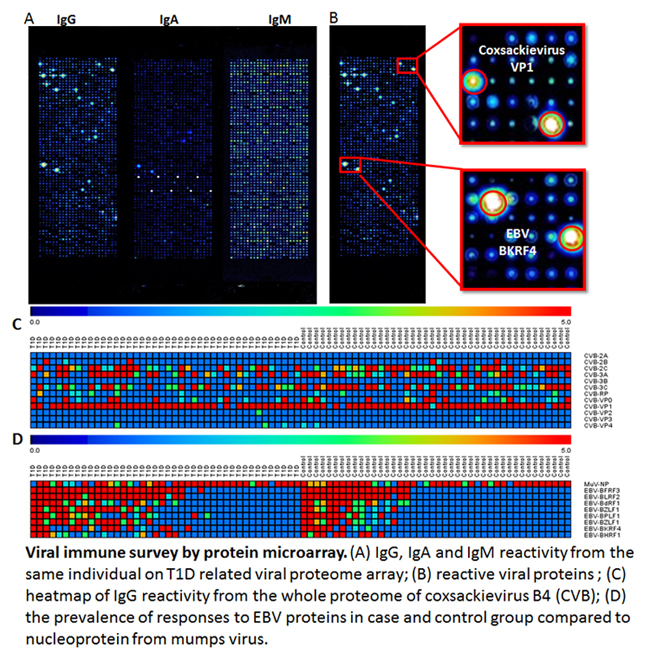LaBaer Lab | Home
Type I Diabetes
Disease Background
| Who gets it? What are the symptoms?
|
How do we detect it now? How is it currently treated?
|
What are the current challenges?
|
Our Approach
The use of protein array to study autoimmunity in type 1 diabetes
Investigators: Ji Qiu, Ph.D., Garrick Wallstrom, Ph.D. and Xiaofang Bian
Collaborators:Shane Miersch, Ph.D. (University of Toronto), Desmond Schatz , M.D. and Mark Atkinson, Ph.D. (University of Florida)
 Type 1 diabetes stems from a defect in immune surveillance that compromises self-tolerance to pancreatic islet antigens and results in the selective targeting, destruction and progressive loss of beta cells. This ultimately impairs the ability to secrete insulin, maintain blood glucose homeostasis and if left untreated will result in mortality. This disease affects 10-20 million persons worldwide, altering the lifestyle of the afflicted and pre-disposing them to a host of severe secondary complications. Affected individuals require daily uncomfortable insulin intervention which causes economic burden for a lifelong time and affects individuals during their most productive years.
Type 1 diabetes stems from a defect in immune surveillance that compromises self-tolerance to pancreatic islet antigens and results in the selective targeting, destruction and progressive loss of beta cells. This ultimately impairs the ability to secrete insulin, maintain blood glucose homeostasis and if left untreated will result in mortality. This disease affects 10-20 million persons worldwide, altering the lifestyle of the afflicted and pre-disposing them to a host of severe secondary complications. Affected individuals require daily uncomfortable insulin intervention which causes economic burden for a lifelong time and affects individuals during their most productive years.
Humoral autoantibodies to pancreatic antigens can be detected prior to presentation of overt symptoms and have both diagnostic and prognostic clinical value. There has been an ongoing effort to identify immunological serum biomarkers for T1D since the 1980s, and a number of autoantibody biomarkers have been identified and associated with T1D such as insulin, GAD, IA2 and ZnT8. These autoantibody biomarkers could be used as a diagnostic tool to predict T1D. However, due to the heterogeneity of this disease, these known autoantibody biomarkers are not found in all patients and identifying additional biomarkers will enhance diagnosis and unveil the pathogenesis of this disease .
This project takes advantage of the Nucleic Acid-Programmable Protein Array (NAPPA) platform to screen a large collection of human proteins to discover more biomarker candidates in T1D. Slides displaying human proteins are challenged with sera samples from either T1D patient or age and sex matched controls. Signal intensity between patient and control sera will be analyzed by statistical tools, and top candidates from screening will be validated by another independent method—Luciferase Immunoprecipitation Assay(LIPS). The final goal of this study is to find novel biomarkers in T1D. The ultimate goal is that these markers could help (1) Increase diagnostic sensitivity and specificity; (2) Define and classify T1D subtypes; (3) Predict disease activity and severity; (4) Trace the progression of disease; (5) Characterize the effects of treatments.
Role of viral Infection in the development of type 1 diabetes
Investigators: Ji Qiu, Ph.D. and Xiaofang Bian
Collaborators:Desmond Schatz , M.D., Clive Wasserfall, MS, and Mark Atkinson, Ph.D. (University of Florida)

This project aims to investigate the association between viral infection and the development of Type 1 Diabetes by systematically examining the antibody responses to individual viral proteins in T1D patients at proteomic level on protein arrays.
Publications
Miersch S, Bian X, Wallstrom G, Sibani S, Logvinenko T, Wasserfall CH, Schatz D, Atkinson M, Qiu J, Labaer J. (2013) Serological autoantibody profiling of type 1 diabetes by protein arrays. J Proteomics. 2013 Oct 19. pii: S1874-3919(13)00530-7. doi: 10.1016/j.jprot.2013.10.018. [Epub ahead of print] Abstract

